HPSM 2012
6th International Conference on High Performance Structures and Materials
19 - 21 June 2012
New Forest, UK
Overview and Opening Address
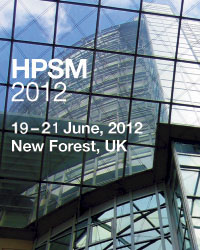
The 6th International Conference on High Performance Structures and Materials was held in the New Forest, UK, the home of the Wessex Institute of Technology. The meeting was organised by the Wessex Institute of Technology (WIT), represented by Professor Carlos A Brebbia; the Free University of Brussels, represented by Professor Patrick De Wilde; and the University of A Coruña, represented by Professor Santiago Hernandez.
The Conference followed the success of the previous five meetings in the series, held in Seville in 2002, Ancona in 2004, Ostend in 2006, the Algarve in 2008 and Tallinn in 2010.
The conference addressed issues involving advanced types of structures, particularly those based on new concepts or new materials. The objective of many papers was to search for higher performance but altogether sustainable materials of the type which are now receiving increased attention.
Contributions also indicated a series of current trends in structural design, including the interactions of the key components, ie natural selection, component design, structural and constructive design. These trends take into account optimisation principles in such a way that the maximum amount of structural material can be transformed, re-used, dismantled and displaced. These concepts contribute significantly to the sustainability of the constructions. An excellent example of this principle is included in a special session on Transformable Structures, organised by Professor Niels De Temmerman and some of his co-workers, which included such case studies.
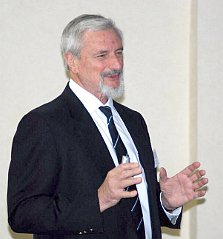
The Conference programme – Carlos explained – aims to attract interdisciplinary researchers, some of them dealing with social, economic and humanistic topics as well as with physical sciences. The success of the programme consists in its ability to evolve, changing the conference topics and always introducing new meetings to replace those that do not require any further advanced research.
Carlos finally noted the work of WIT Press, the publishing arm of the Institute, which in addition to the conference books, produce a large number of other monographs and edited volumes as well as a number of learned Journals. This work is now further disseminated around the world by the emergence of digital books. Hard cover volumes continue to be printed – on demand. All conference papers, Carlos explained, are archived in the Web library of the Wessex Institute (http://library.witpress.com/) where they are permanently available to the international community.
Carlos ended by hoping that the delegates will have a very successful meeting and that they will continue to collaborate with WIT. This collaboration includes the possibility of submitting an extended version of their papers for publication in the International Journal of Computational Methods and Experimental Measurements.
Conference Sessions
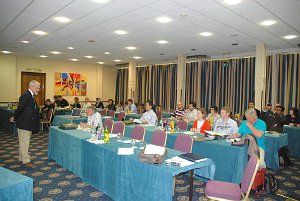 The conference sessions included a series of interesting papers organised around the following topics:
The conference sessions included a series of interesting papers organised around the following topics:
- Emerging structural applications
- Material characterisation
- Composite materials and structures
- High performance concretes
- Steel structures
- Experimental and numerical analysis
Special Sessions
The conference has two special sessions, one of them organised by Prof K Takemura from Kanagawa University, Japan which included the following papers:
- Mechanical performance of bacterial cellulose nanofibre-reinforced expoxy composites
- Effects of microfibrillated cellulose addition and water absorption on mechanical properties of Jute/PLA composites
- Elastic and dynamic response characteristics of Kenaf/polypropylene composites
- Development of green composites using agricultural waste
- Effect of treatment using silane coupling agent on creep properties of Jute fibre reinforced composites
Another excellent special session was organised by Prof Niels De Temmerman from the Free University of Brussels, on the topic of moderate span bridges. It included four papers on:
- Transformable structures in architectural engineering
- Structural optimisation of deployable scissor structures using new computational methods
- Four-dimensional design of multimodular footbridges in developing countries
- Analysing the applicability of deployable scissor structures in responsive building skins
Joint Session
The conference held a joint session with the 12th International Conference on Optimum Design of Structures and Materials in Engineering. The session, chaired by Carlos Brebbia, dealt with the Optimization of Civil Engineering and consisted of the papers entitled:
- A software with graphical interface for design optimization of prestressed concrete launched bridges
- Optimization of thick-walled shells based on solving inverse problems of the elastic theory for inhomogeneous bodies
- Performance based design of masonry infilled reinforced concrete frames for near-field earthquakes
Keynote Addresses
Furthermore there were a series of keynote addresses to enhance the meeting:
‘An application of Taguchi’s method to robust design of aircraft structures’
by S Hernandez, University of A Coruña, Spain
‘Effective mechanical and transport properties of polysiloxane matrix based composites’
by M Sejnoha, Czech Technical University, Prague
‘Internal pressure – stressing and forming’
by I Doltsinis, Stuttgart University, Germany
‘Shape optimal design of phases in composites: harmonic problem
P P Prochazka, Czech Technical University, Prague
‘An analytical model for deformation analysis of composite wind turbine adaptive blades;
A Maheri, Northumbria University, UK
Eminent Scientist Medal
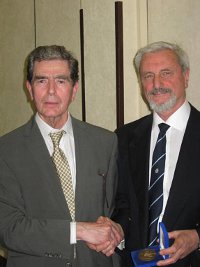
After completion of the Diploma studies, Doltsinis was invited by Professor John Argyris to join the scientific staff of the renowned Institute for Statics and Dynamics of Aerospace Structures (ISD) at the Stuttgart University. In the Institute, as a research fellow for computational nonlinear mechanics he devoted himself to the subject of engineering plasticity working on FEM elastoplastic analysis, in the focus of international efforts that time. His developments extended the range of general purpose software to the area of inelastic large scale computations in industrial engineering practice. Parallel to this work, he conducted as the project leader R&D in Wide Span Lightweight Structures (originating from the unique roof of the Olympic Stadium in Munich 1971), Nonlinear Fracture Mechanics and Composite Materials.
Continuing as the responsible scientist of R&D on Thermomechanics and mechanics of Materials, he worked on the challenging subject of large deformation of elastoplastic solids and coupled field problems. He was the first to consistently model superplastic forming for the aerospace industry, and to develop process simulation on the grounds of hyperelasticity in a theoretically transparent and computationally efficient manner. In this context he initiated in his teams and founded the development of the Finite Element Programming Systems (FEPS) as a research tool dealing with highly nonlinear, physically coupled problems including thermomechanical deformation processes, viscous fluid motion and fluid-structure interaction. The software, conceived for research purposes, has been denoted the first handling multiphysics.
In 1984 he moved to the Institute for computer Applications (ICA) then just founded at Stuttgart University, appointed later as the Deputy Director of the Institute. The position enable interdisciplinary research along new direction: microstructural failure processes in multiphase materials, CFD for hypersonics with chemical reactions and Stochastic Mechanics. Research projects for industrial purposes refer to Plasma-sprayed Ceramic Thermal Barrier Coatings, Strength of Porous Ceramics as for the Reliability of Filtration Equipment, Re-entry Aerothermodynamics within the European Hermes Space Shuttle Programme and Stochastic Methods in Industrial Aerospace and Automotive Engineering. Most recent developments have focussed on Stochastic methods in Computational Mechanics.
Doltsinis was and is engaged as an expert consultant for Research Councils and Foundations within Germany (like Volkswagen Foundation) and abroad. He has been on the managing board of the European Research Community of Flow, Turbulence and Combustion (ERCOFTAC), belongs to the Scientific Advisory Committee of the Institute of Systems Engineering and Computers (INESC), Coimbra, Portugal, and is a Fellow of the Wessex Institute of Technology.
As a Visiting Professor at the University of Trento, Italy, he transferred knowledge on advanced computational methods in engineering, Courses in the Faculty of Aerospace Engineering in Stuttgart comprise Loading Systems on Aircraft, Elastic-plastic Behaviour of Structures, Stochastic Analysis and Optimization. Research results have been published in numerous international professional journals. Based on his experience in engineering research and education, he authored the books
- Elements of Plasticity – Theory and Computation
- Large Deformation Processes of Solids – Fundamentals and Engineering Applications
- Stochastic Methods in Engineering
All of these have been published by WIT Press. The most recent one – Stochastic Methods in Engineering – has been motivated by the increasing demand in the industry for introducing uncertainty in the design process, and the necessity for acquiring fundamental background knowledge on the subject.
At the end of Ioannis’ address Carlos Brebbia presented him with the Eminent Scientist Medal given by the Wessex Institute of Technology to outstanding researchers. Awardees include renown scientists and engineers from all over the world; the first of the medals being awarded in 1986 to Professor Eric Reissner of MIT.
Book Launch
The conference was the occasion of a new book by Professor Ioannis Doltsinis of Stuttgart University, on ‘Stochastic Methods in Engineering’ that points out the importance of probabilistic models in engineering analysis and design in which to account for the random infection of actual systems.
Stochastic Methods in Engineering covers computational stochastic analysis and optimization. It begins by introducing concepts and then outlines computational approaches to specific classes of problems. Emanating from the author’s courses at the Faculty of Aerospace Engineering at the University of Stuttgart, the book is intended to make the reader familiar with the stochastic point of view, exploring and quantifying random system variability, its source and sensitivity. It also develops methods of stochastic analysis and optimization based on deterministic knowledge, serving as a guide in the transition from determinism to stochastics.
The book begins by introducing concepts of stochastic analysis and design optimization, outlining computational approaches to specific classes of problems, referring first to elastic structures, geometric nonlinearities and elastoplasticity. Two fundamentally different methods are considered in this context and are developed on the basis of the finite element formalism: the analytical Taylor expansion approach and the synthetic Monte Carlo technique. In fact, the single volume is unique in presenting tutorials on essential probabilistics and statistics, recent finite element methods, and Monte Carlo simulation techniques. The considerations are extended to the important issue of system reliability, time variant phenomena and material deformation processes. Supplementary, statistical assessment and comparison of systems is exposed, which is of interest also when validating analysis models by laboratory testing.Social Occasions
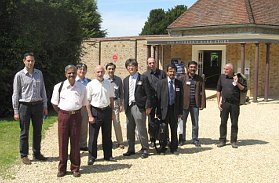
In addition they were invited to participate in a lunchtime excursion to one of the most beautiful sites in the New Forest, ie Bucklers Hard, to which they were taken by bus and offered a packed lunch.
Bucklers Hard is a very picturesque village of great historical interest lying on the Beaulieu River. It was a shipbuilding village, which at its height had five slipways and around 20 cottages for the workers. Only two rows of cottages now remain with a broad village street separating them and sloping towards the river. At the end of one row stands a hotel, which was the Master Builder’s house. An excellent display at the entrance of the village describes the activities that took place there.
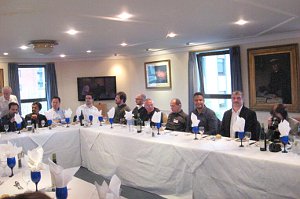
The weather was kind to the delegates who had occasion to sit on the wooden benches on the river shore and partake of their picnic lunches. They were able to walk around the place and visit the pub as well as a tiny chapel located in one of the builders’ cottages.
The conference banquet took place in the Royal Southampton Yacht Club located on a well known marina. Carlos explained about the history of the Club and its association with internationally renowned sailing events. The dinner consisted of excellent dishes accompanied by well balanced wines.
Carlos proposed a toast to the success of the meeting and in particular to Professor Ioannis Doltsinis, upon being awarded the Eminent Scientist Award. At the end of the dinner Carlos offered all participants a ceramic dish, the work of a local potter who still uses traditional methods for the whole process. The pieces are works of art in their own right and will help the delegates remember the happy occasion of their visit to the Southampton area and in particular the New Forest.
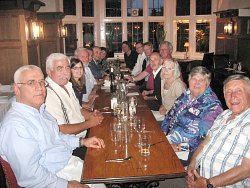
The lamb BBQ has become a tradition of Wessex Institute, the quality of lamb meat from Hampshire being renowned. The convivial atmosphere and general fare contributed to make this a unique experience for the visitors.
The International Scientific Advisory Committee of the conference met over dinner to discuss ways in which the meeting could be improved when it is reconvened in 2014. Different new topics were put forward as well as new members nominated. There were several suggestions for locations and venues which will be investigated by the Conference Director of WIT.
Closing of the Conference
The meeting was closed by Carlos who expressed his appreciation to the delegates for having participated in HPSM 2012. He hoped that they found the experience rewarding and will take part when the conference is reconvened in 2014, at a location and date to be shortly decided. He concluded by reminding the authors of the possibility of submitting an extended version of their paper for publication in one of the International Journals published by WIT Press.
Conference Proceedings
The proceedings of HPSM, 528pp (Print ISBN:978-1-84564-596-0 , eISBN 978-1-84564-597-7) are available from WIT Press. Orders can be placed on the WIT Press web site at www.witpress.com or by email:
Papers from the conference will also be hosted online at the WIT eLibrary as Volume 124 of WIT Transactions on the Built Environment (ISSN: 1746-4498, Digital ISSN 1743-3509). For more details visit the WIT eLibrary at http://library.witpress.com

 Wessex Institute
Wessex Institute